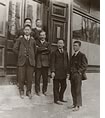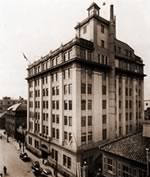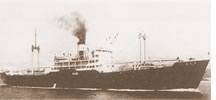- Home
- Company Profile
- Historical Background
- History
- 1911-1950
1911-1950
- 1911-1914
Company's inception - 1914-1919
The First World War - 1919-1932
The postwar years - 1932-1941
Steady growth - 1941-1945
The Second World War - 1945-1950
Restarting after the war
1911-1914 Company's inception

In January 1914,the company established Taisho Kaiun, a wholly owned subsidiary in Dalian, China. Meiji's ships were now connecting Japanese ports with Hong Kong, Singapore, Manila and Hawaii.
1914-1919 The First World War
The outbreak of World War l ignited demand for marine transportation. During this period, Japan's shipping industry expanded its network to include North and South America and other parts of the world. The company responded by purchasing more ships and building its first one in 1916, followed by the second and third in 1917.
A remarkable record was attained in 0ctober 1916 when the profit ratio of paid-up capital before depreciation was 688.1 percent, and the dividend reached 25 percent. There was no debt and employees received semi-annual bonuses of between 50 and 60 months' wages.
1919-1932 The postwar years

1932-1941 Steady growth
After a lengthy postwar stagnation, the marine transport industry in Japan began recovering in 1937, sooner than other areas of the world. This was primarily due to growth of exports and domestic industries under inflation brought about by demand during the war. Meiji Shipping demonstrated stable and steady growth, with dividends increasing from 4 percent in April 1933 to 12 percent 1938. After that it remained at 10 percent. In December 1938, the company built its first ship equipped with a diesel engine, and in 1940, a wing was added to Meikai Building.
1941-1945 The Second World War
During World War ll, the oceans of the world became battlefields. Ships and ports were destroyed as the war intensified, paralyzing sea transportation. Meiji Shipping built a new vessel in 1940 and absorbed Goshu Kisen in 1943 and Taisho Kaiun in 1944 to expand its fleet. Yet the war's toll on the firm was extensive: 16 vessels totaling 112,161 tons were lost, leaving only two wartime standard ships, M/S Meiyu Maru and M/S Meio Maru with a combined tonnage of 12,576. In addition, an air raid in June 1945 damaged The Meikai Building.
1945-1950 Restarting after the war


